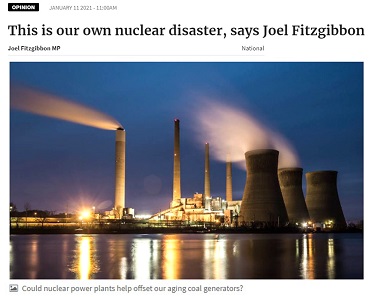Reality has a way of asserting itself, breaking the nominal left- versus right-wing political divide. The bipartisan net-zero carbon dioxide emissions goal has been slammed as “a regions job killer” by former ACTU President Jennie George. She is among a growing chorus of Labor and selfidentifying “left-wing” leaders who understand that the most vulnerable in society will be forced further into poverty under a decarbonisation regime. Labor Party MP Joel Fitzgibbon, the Member for Hunter in NSW’s coal country, also understands this, as he came close to losing his seat at the May 2019 federal election. Fitzgibbon insists that the coal industry’s “future is strong”; but more importantly, he has prominently opposed Australia’s ban on nuclear power. This opens the only economically viable path to reduce emissions growth without smashing the economy and pushing Aussie battlers further into poverty.
Jennie George’s opinion column “The false promises of green-tech energy”, in the 4 February Australian, hit the nail on the head as to the plight of working families under an aggressive emissions reduction regime. She rightly condemned Prime Minister Scott Morrison’s foolish “green” rhetoric: “It was interesting to hear Scott Morrison embrace the mantra of green steel this week. The problem is that while it could provide opportunities for electric arc furnaces in mini-mills, it is not suited to blast-furnace steelmaking at Port Kembla. Again, it’s important not to raise false expectations. … It is a pity advocates of such technologies don’t tell the community the whole truth: there are no proven and commercially viable technologies to replace coal/coke in the blast furnace steelmaking process at BlueScope in the Illawarra. Is it a just transition to see integrated steelmaking lost to the nation? Try convincing the thousands of workers and their families that this is the price they will have to pay.”
The “magical transition to ‘green steel’”, as George explains, fits with the foolish attempt to run heavy industry on solar and wind power. George noted this with reference to the Tomago aluminium smelter near Newcastle: “Renewables are not commercially viable, nor can they guarantee the required reliability for the smelter’s continued operation. The largest South Australian battery today would power that smelter for less than 15 minutes.”
Coal here to stay
Under the title “The truth about coal is that its future is strong”, Joel Fitzgibbon’s article in the Australian on 12 February noted that each year we export about $26 billion worth of thermal coal for electricity generation and $43 billion worth of metallurgical coal for steelmaking. He too ridiculed the “still-mythical ‘green steel’ revolution”, noting that “the growing nations of Asia are going to be hungry for our high-quality metallurgical coal for many decades to come”.
“In thermal coal-dominated NSW, $6 billion worth of expansion projects await regulatory approval. Those who transport our coal by rail to port also have capacity expansion plans”, continued Fitzgibbon. And they have good reason, as he went on to explain: “In a deep global recession, China’s coal-fired power generation grew by 38 gigawatts last year. That’s the equivalent of 19 new Liddell power stations. Indeed, China has 127 new coal-fired plants in the pipeline. It is not alone; Indonesia is building 52, India 28, Japan 22 and Vietnam 17. Many of India’s units were built in the past decade and have a long way to run.”
The Australian on 15 February reported how the hard-line emissions-reduction position in the Labor Party is meeting internal resistance. While some in the party have attempted to restrict gas-fired power stations as well as coal, others such as Senator Alex Gallacher are speaking out. “With the uptake of solar and wind, we are going to face an unreliability along the way. Given there is no investment in coal-fired power stations, the only option is gas”, Senator Gallacher said. “This is actually the evidence of the success of the climate change advocates that we now face unreliability in the sector. My view is: so what if they want to do a bit of gas.”
Nuclear power enters debate
Fitzgibbon’s 10 January column “Our own nuclear disaster”, published in several Nine News (former Fairfax Media) newspapers nationwide, is one of several recent calls to end Australia’s illogical ban on nuclear power. The 1990s prohibition of nuclear power wasn’t about keeping us safe, Fitzgibbon opined; “rather, it was about politics”. And as anti-nuclear sentiment in Australia was high, activists “mischievously conflated nuclear weaponry with civil nuclear uses and waste disposal”.
The dangers of nuclear power were seriously exaggerated by misinformed activists, while actual experts had the opposite view: “Parliamentary bookshelves around the country are full of committee, Royal Commission, and other expert reports which recommended the embrace of nuclear [electricity] generation in Australia”, Fitzgibbon explained.
“The latest generation of nuclear plants are smaller, enabling faster, safer, less expensive, and more standardised construction. No longer dependent on large amounts of water for cooling purposes, they can be built in remote locations, well away from our predominantly coastal communities. Indeed, they can be built underground. These new technologies have the potential to overcome what may be the greatest barrier to local nuclear generation in Australia, the ‘not in my backyard’ syndrome.”
There are 442 operable nuclear reactors in 32 countries, 53 under construction, and 424 planned or proposed as reported by the World Nuclear Association for January 2021. Australia must embrace this nuclear renaissance, which as Fitzgibbon emphasised, could create hundreds of thousands of jobs along the nuclear fuel cycle as well as opening employment opportunities in other sectors.
By Jeremy Beck, Australian Alert Service, 17 February 2021







